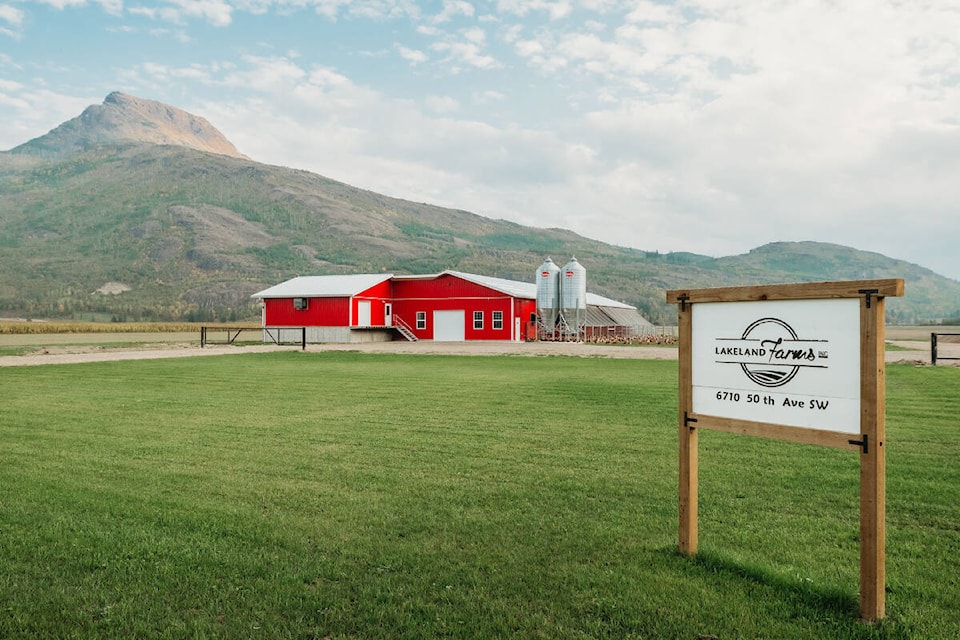Mike Schroeder has been working hard to improve soil health on his farm.
Lakeland Farms in the Salmon Valley is certified organic and, since 2015, it’s been producing grains for food and animal feed, as well as table eggs.
Since 2016, Schroeder has been experimenting with different cover crops. He recently shared results of some of his cover crop trials.
A cover crop, Schroeder explained, is a crop grown in a shoulder season or winter, before or after a cash crop (like corn or wheat). He said for his farm, the number one purpose of growing cover crops is to improve soil health.
“When they cleared land and started farming here, the soil would have had eight to 12 per cent organic matter,” he said. “Now we’re down to two-and-a-half or three… organic matter’s where a lot of our nutrients are stored. Our first goal when we started using cover crops was to build organic matter.”
A livestock-based farm could graze animals on a cover crop and have the animals release nutrients back into the soil that way. Since Lakeland Farms isn’t currently livestock based, Schroeder uses tillage to turn a lot of his cover crops back into the soil as “green manure.”
When cover crops are mixed back in with soil, the soil can absorb their nutrients and can retain more water — the cover crops can essentially work like a fertilizer.
Lakeland Farms received a grant from the Shuswap Watershed Council which helped Schroeder to plant cover crops across his whole farm. Schroeder told the Observer about a cover crop that didn’t go so well, and one which went very well.
This past winter, Schroeder grew a winter wheat cover crop ahead of a buckwheat cash crop. The winter wheat was planted in fall 2020 and it germinated, established, then went dormant through the winter.
“In the spring, it started growing again which was great because that’s what we wanted… to let that grow until late May to build up a bunch of biomass and capture a bunch of nutrients,” said Schroeder.
Unfortunately, this past summer’s drought threw a wrench into Schroeder’s plans.
“We let that crop grow too long… in a dry season, it used up all of our moisture. So when we went to plant our buckwheat crop, we got it to germinate and establish, but there was just not enough moisture there for a high-yielding crop.”
While using the cover crop significantly reduced Schroeder’s cash crop yield, he did not attribute the failure to the cover crops themselves, rather his management of them. He said the buckwheat cash crop would have been just fine if his farm had irrigation as a tool in its growing area.
On the flip side, Schroeder has found a cover crop process he calls his favourite: frost-seeding clover into a winter cereal crop. A winter cereal will be planted in September, germinate, establish, then go dormant through the winter. As soon as the snow is gone, around March, clover seed will be spread over the live cereal crop.
“The soil freezes and thaws, expands and contracts, and it pulls the (clover) seed into the soil… It germinates when the temperature warms up and it pops out of the soil and puts down a root system,” said Schroeder.
When the cereal cash crop takes off, it shades in the clover cover crop, which then goes dormant because it can’t get any sunlight. When it’s ready, Lakeland Farms will harvest the cereal crops’ grain and spread the remaining straw back on the field.
“Because we harvested the cereal crop, the sunlight can now hit the clover crop underneath and it grows up through that mat of straw. We can get a foot-and-a-half of biomass with clover, which is fixing nitrogen, improving soil tilth (condition), increasing organic matter, increasing water infiltration — all the good things we want cover crops to do.”
Schroeder said clover, a legume, has a symbiotic relationship with a bacteria in its roots which can pull nitrogen out of the air. The nitrogen is stored in the clover’s tissues, and when it’s mixed back in with the soil as green manure, the nitrogen is released. That’s good news, because Schroeder said nitrogen’s really expensive and one of the main nutrients every crop needs.
Frost-seeding clover into winter cereal crops allows Schroeder to go about a year-and-a-half without tilling the field he seeds, which he said is “huge.” It saves Lakeland Farms money in diesel, manpower, and maintains soil health since tillage is bad for soil.
Schroeder said he thinks what might hold other farms back from using cover crops is learning the production practices to get the crops to work within their systems.
Upfront cost can also be a barrier for those looking to implement cover crops. Long-term, Schroeder hopes to bring livestock onto his farm and graze off cover crops to see some upfront value.
“The way we’re using them as a soil health tool…, it’s a slow process to improve soil,” he said. “For a lot of producers, I think it would be difficult to make the investment, knowing that you’re not going to see a quick return.”
“The cover crop report we wrote with the Watershed Council, it was just to give an example of the management practices we tried to use for cover crops, the results that we saw, and the opportunities… for deriving value from them for farms,” said Schroeder.
He added the City of Salmon Arm has been very supportive of agriculture, as it’s a big part of the local economy.
“We want to show the community that farms around Salmon Arm are being proactive about things like soil health,” said Schroeder.
Read more: Shuswap community rallies behind ‘Halloween House’ fundraiser
Read more: New Salmon Arm non-profit offers programs for Indigenous women, families, youth and children
Do you have something else we should report on? Email: zachary.roman@saobserver.net
Like us on Facebook and subscribe to our daily newsletter.
